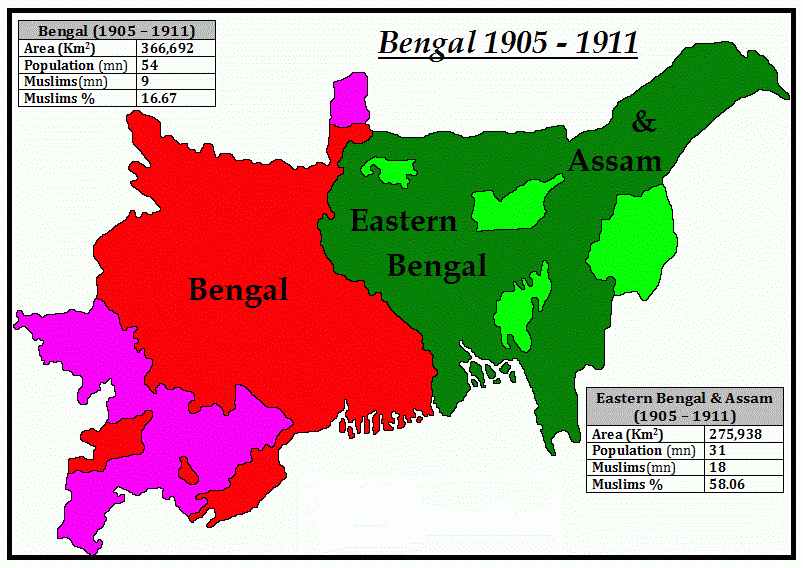The wave of nationalism reached its zenith at the end of the 19th century. The colonial government initially presented itself as a reformist type government that will help the native Indians for their freedom. But due to the rise of nationalism among the educated youth and especially in Bengal province, Indians now started to question the oppressive policies introduced by the colonial British government.
Content
Partition of Bengal: Background
Famines, reform in arms act, the introduction of the legislative council, etc. were some key issues that were raised by political organizations like INC (Indian National Congress), Indian Association, British Indian Association, etc. The introduction of the Charter Act of 1853 also forced Indians to raise their voices against the British Authority.
Lord Curzon, who was strictly against Democratic rights for the Indians became the Governor-General of India in 1889. By this time both nationalism and political consciousness had gained significant impetus.
Furthermore, the Bengal province of British India was the center of all the nationalist movements. To suppress the nationalism ideas among the public of Bengal Lord Curzon along with Lieutenant Governor Andrew Frazer and H.H. Risley jointly planned to divide Bengal. The population of undivided Bengal at that time was estimated to be around 8 million.

At that time Bihar, Odisha, modern-day west Bengal, Assam was part of Bengal province of British India. Lord Curzon wanted to establish a proper Muslim majority province in East Bengal with Dhaka as its capital. To divert the mind of educated Indians from his dark politics Lord Curzon gave the reason for establishing a good administrative hold on Bengal. (Divide and Rule Policy)
Curzon never wanted to give full rights to Indians and was against political organizations like INC (Indian National Congress). Furthermore, the Muslim population residing in East Bengal was not much educated, this gave Curzon an advantage to divide Hindu and Muslims.
Lieutenant Governor of the new province, Sir Andrew Frazer’s views were this
“He said he had two wives one is Hindu and the other Muslim and the Muslim one was certainly dearer to him.”
H.H.Risley said,
“Our main motto is to suppress the power of our enemies (Indians), he looked united Bengal as a symbol of power and divided Bengal as a division of power.”
On 16 October 1905 Lord Curzon partitioned Bengal. Calcutta was made the capital of West Bengal while Dhaka was made the capital of East Bengal.

The Nawab of Dhaka i.e. Salimullah welcome this decision and later was a strong critique of the Swadeshi Movement. Nawab Salimullah also played a significant role in the formation of the Muslim League in 1906 which was the major cause of Pakistan’s formation. Due to this, the British government was able to divide Hindu Muslims.
Rise of Nationalism After Partition
Nationalist leaders through print media presented their views and aggression on this issue. They also suggested that the partition of any region or state should be done on the basis of language, historical significance, cultural and economic differences. But Lord Curzon denied these facts and divided Bengal for dividing Hindus and Muslims.
After hearing the news of the Partition of Bengal Indian Nationalist leaders like Krishna Kumar Mitra, Surendra Nath Banerjee and Rabindranath Tagore launched powerful press campaigns to unite Indians against the Divide and Rule policies of the British.

Partition of Bengal
INC leaders believed in moderate methods of protests. Singing petitions, conducting speech, condemning the decision of partition in public meetings and at their national session. But this method of protest could not able to do much damage to the British government.
Due to this the INC witness a new type of leadership within itself. Leaders like Bal Gangadhar Tilak, Lala Lajpat Rai, Aurobindo Ghosh decided to initiate an aggressive method of protest.
The new leaders strongly focus to adopt the policy of economic self-reliance. Bipin Chandra Pal in his paper New India, Aurobindo Ghosh in Bande Mataram, and Badrinath Ghosh in Yugantar strictly focused on the annulment of the Partition of Bengal. He also wanted to adopt a new form of protest as moderate and peaceful language was not enough to claim our rights from the British.
Muslim leaders like Din Muhammad, Didar Baksh, Liyakat Hussain were also against the partition of Bengal. However, the partition of Bengal was able to divide Hindu and Muslims.
Annulment of Paritition
Mass political protests were organized as a result of the partition. Swadeshi and Boycott movement was launched by nationalist leaders like Dadabhai Naoroji, Bal Gangadhar Tilak, Bipin Chandra Pal, Aurobindo Ghosh, etc. Due to mass protest and significant loss in the economic sector, the British government annulled the partition of Bengal in 1911. This was the first time when the British bowed in front of Indian leaders.
But the British were able to create a communal divide and a separate province of Assam, Bihar, and Odisha were created. They also shifted the capital of British India i.e. Calcutta to Delhi.
LIKE WHAT WE ARE DOING? DONATE TO DHARMAYUDH !
If you Support what we are doing and would like to contribute to help us grow and reach more Indians to teach them more about such forgotten historic Indian Heroes and stories, please consider donating any amount. It will help us grow.


One comment